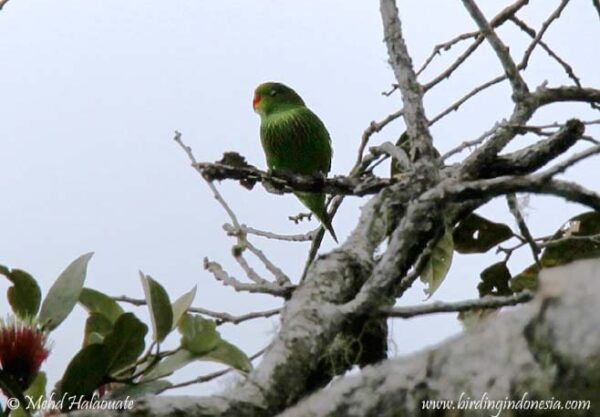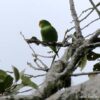Pygmy Lorikeet
Also known as:
Wilhelmina's Lorikeet, Pygmy Streaked Lorikeet
Also known as:
Wilhelmina's Lorikeet, Pygmy Streaked Lorikeet
DID YOU KNOW?
The Pygmy Lorikeet is the smallest lorikeet in the world, weighing in at only 20 g (0.7 oz).

Charmosyna

wilhelminae
Size:
13 cm (5 in)
Weight:
20 g (0.7 oz)
Subspecies including nominate:
one
Colour Adult:
Male-purple/brown crown and nape, the nape streaked with blue; hindneck has olive wash; red lower back; rump dark purple/blue; breast streaked with yellow; underwing coverts red; stripe under the wing red; tail green tipped with yellow, with red at base of side feathers. Beak orange. Eye orange/red. Female-green lower back and underwing coverts with red underwing stripe absent.
Colour Juvenile:
As in adult but with little or no streaking on breast or nape; red underwing coverts and stripe under wing in males, but lower back purple. Beak brown. Eye brown.
Call:
Are described as high-pitched and not unlike those of Micropsitta parrots, but with harsh notes of other lorikeets.
More Information:
Content Sources:
CITES
BirdLife International
Cornell Lab of Ornithology/Birds of the World
Parrots: A Guide to Parrots of the World, Juniper and Parr, 1998
Parrots of the World, Forshaw and Cooper, 1977. 2010 edition
Lexicon of Parrots, Thomas Arndt.
Parrots of the World, Forshaw, 2006.
Parrots in Aviculture, Low, 1992.
Captive Status:
Uncommon.
Longevity:
—
Housing:
Enclosure with well-drained floor, suspended over concrete base, or indoor aviary 1.2 m (4 ft) long in room with tile on walls and floor.
Diet:
Nectar, either a commercial type specially formulated for small (Charmosyna, etc) species, or a mixture of baby cereal (lactose-free), honey and malt extract or molasses, mixed with filtered water, made fresh once or twice daily; fruits such as: apple, pear, cactus fruits, etc.
Enrichment:
Provide branches (bird-safe and unsprayed) with blossoms so the birds may have the pollen and nectar; provide shallow dish for daily bathing.
Nest Box Size:
—
Clutch Size:
2
Fledging Age:
Probably about 7 weeks.
Hatch Weight:
—
Peak Weight:
—
Weaning Weight:
—
World Population:
Unknown but reported as uncommon. Stable.
IUCN Red List Status:
Least Concern
CITES Listing:
Appendix II
Threat Summary:
Generally uncommon but easily overlooked with few observations recorded.
Range:
Found in the highlands of New Guinea.
Habitat:
Occurs in montane forest margins and adjoining savanna woodland, frequently descending into lowland forest at bases of mountains or at sea level. Found from 1000-2200 m (3280-7216 ft).
Wild Diet:
Feeds on nectar and pollen; recorded trees include eucalypts and Castanopsis oaks, as well as Elaeocarpus flowers and stems.
Ecology and Behaviour:
Seen in pairs and small flocks of up to 20 individuals in the canopy of flowering trees. Often seen with Goldie’s and Fairy Lorikeets. Active feeders. Difficult to detect because of nearly all green plumage.
Clutch and Egg Size:
2 rounded eggs, 17.0 x 13.5 mm (0.7 x 0.5 in).
Breeding Season:
—

